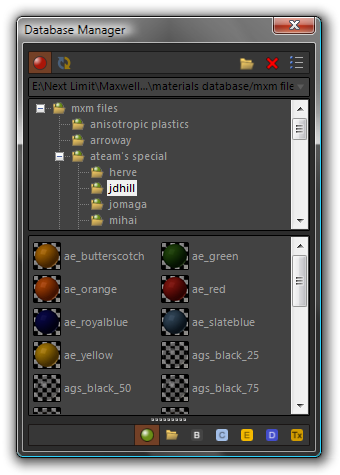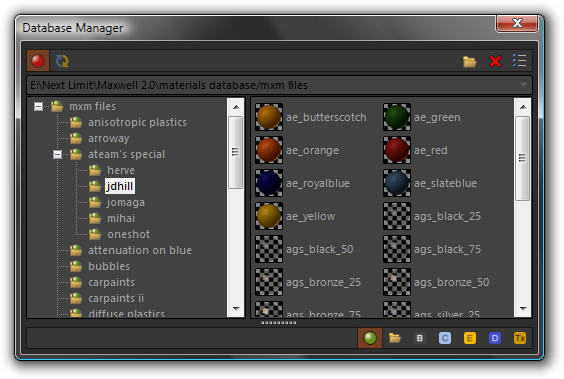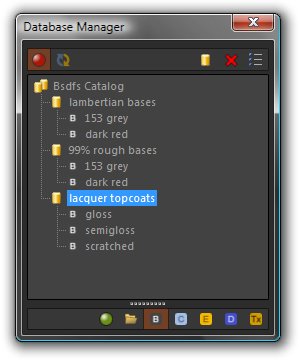Rhino 5 - Database Manager
The Database Manager provides access to MXM files stored on your machine, as well as collections of individual material components (i.e. BSDFs, Emitters, etc.).
Similar to the Scene Manager, the Database Manager may be used either as a standalone window, or as a Rhino dockbar, by using Options > User Interface > Dockable Database Manager. The top toolbar in the Database Manager is context-sensitive, meaning that the buttons it has take on different meanings depending on which page is currently selected:
The buttons on the left do not change, and they have the following functions:
| Button | Function |
|---|---|
| Enable Real-time materials | When this button is enabled, the plugin will adjust the viewport appearance of materials in real-time as they are modified in the Material Editor. If it is not enabled, the plugin will not alter the appearance of objects in the viewport. |
| Refresh Viewport materials | For various reasons, it may occur that the viewport appearance of Maxwell materials may become unsynchronized. When this happens, or when ‘Enable Real-time materials’ is not enabled, using this button will bring the viewport up to date. |
The Database Manager window contains seven pages, which are accessed using the buttons contained in the bottom toolbar:
The first button shows the plugin's MXM Browser which is used for importing and exporting Maxwell MXM files. The remaining buttons show Catalog pages, each one storing a specific type of component, i.e. BSDFs, Emitters, etc.
MXM Browser
The MXM Browser, shown above, is unique among these pages. It contains:
- A drop-down which holds user-defined directories which contain MXM files.
- An Explorer-style folder tree which shows the folder-structure of the selected directory.
- An Explorer-style thumbnail-viewer which shows the MXM contents of the directory selected in the folder tree.
To add a new directory to the MXM Folders drop-down, click on the Browse button in the top toolbar. You will be prompted to select a directory, which will then be added to the drop-down list. Selecting an MXM directory from the drop-down list will cause it to be shown in the tree. Selecting a folder from the tree will cause the MXM files contained in it to be shown in the thumbnail-view below the tree. In the tree, folders which contain MXM files are shown using a different folder-icon than those which contain none. When the Database Manager is wider than it is tall, then the separator bar between the folder-tree and the thumbnail-viewer will switch to a vertical orientation:
MXM files may be imported by dragging them from the thumbnail-view into either the Rhino viewport, or the Scene Manager’s materials page. Additionally, multiple MXM files may be imported by windowing them in the thumbnail view, or by dragging an entire folder from the folder-tree into the Scene Manager’s materials page. materials may also be exported from the scene as MXM files by dragging them from the Scene Manager’s materials page into the thumbnail-view of the MXM Browser.
Catalogs
The other pages are all similar to one another, with each storing one of the following: Layers, BSDFs, Coatings, Emitters, Displacements, and Textures. At the top of each page is a Catalog node. In addition to the single, permanent Catalog node, each page can contain variable numbers of two other node types:
| Type | Purpose |
|---|---|
| Volume | Volume nodes contain other Volume nodes, or Component nodes. |
| Component | Component nodes represent individual BSDFs, Emitters, etc. |
Shown below is the BSDF Catalog page, with three Volume nodes, each containing two or three BSDF Components.
Components can be dragged back and forth between the Material Editor’s layers tree and their respective Database Manager page. They can also be edited in-place while stored in the database by double clicking them in the Database Manager; the Material Editor will be emptied, and the selected component will be loaded into the appropriate Material Editor page.
The components stored in the database are saved automatically whenever a document is saved, and there is no need to be concerned with the files they are stored in; these files are plugin-specific and located somewhere in the app-data folder under your user profile. This location is used to make sure the plugin has permission to write these files. In addition to being saved when the current document is saved, there is also a ‘Save Changes’ button which will appear in the Database Manager’s top toolbar whenever changes have been made which would be lost were the document to be closed without saving – clicking the button will commit the current state of all database components to disk, so it is possible to save them without also saving the document.




